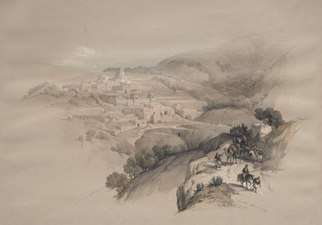The Holy Land, Syria, Idumea, Arabia, Egypt, and Nubia
The Holy Land, Syria, Idumea, Arabia, Egypt, and Nubia was a travelogue of 19th-century Palestine and the magnum opus of painter David Roberts. It contained 250 lithographs by Louis Haghe of Roberts's watercolor sketches. It was first published by subscription between 1842 and 1849, in two separate publications: The Holy Land, Syria, Idumea and Arabia and Egypt and Nubia.[1][2] William Brockedon and George Croly wrote much of the text, Croly writing the historical, and Brockedon the descriptive portions.
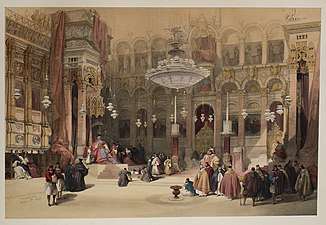 Volume 1, plate 4: "Greek Church of the Holy Sepulchre" | |
| Author | David Roberts |
|---|---|
| Illustrator | David Roberts and Louis Haghe |
| Language | English |
| Genre | Travel literature |
Publication date | 1842-49 |
Described as "one of the art-publishing sensations of the mid-Victorian period",[1][3] it exceeded all other earlier lithographic projects in scale,[2] and was one of the most expensive publications of the nineteenth century.[1] Haghe has been described by the Metropolitan Museum of Art as "the best and most prolific lithographer of the time"[4]
According to Professor Annabel Wharton, it has "proved to be the most pervasive and enduring of the nineteenth-century renderings of the East circulated in the West."[2]
Roberts's travels and publication
Roberts began his travel to the region in August 1838. He landed at Alexandria, and spent the rest of 1838 in Cairo. In February 1839 he traveled to Israel via Suez, Mount Sinai and Petra. From Gaza he traveled to Jerusalem, and around the rest of the region. He returned to England at the end of 1839 after falling ill, having spent 11 months in the region. A total of 272 watercolour sketches were shared with the publisher F.G. Moon in 1840 who paid Roberts £3,000 for copyright to the sketches.[5]
Reaction
Famed Victorian art critic John Ruskin wrote the work was a "true portraiture of scenes of historical and religious interest. They are faithful and laborious beyond any outlines from nature I have ever seen."[6]
Art historian John Roland Abbey wrote in his Travel in Aquatint and Lithography, 1770-1860 that "Robert's Holy Land was one of the most important and elaborate ventures of nineteenth-century publishing, and it was the apotheosis of the tinted lithograph".[7]
John James Moscrop noted in a recent work on nineteenth century knowledge of Israel: "The best known of the illustrators was David Roberts. If Robinson produced the nineteenth century's historical geography of the Holy Land, it fell to a Scottish painter, David Roberts, to illustrate it."[8]
Criticism as orientalism
The images have been widely criticized as providing an orientalist perspective on the region.[9] Uzi Baram wrote: "From Said's critique of Orientalism, it is clear that Roberts created picturesque landscapes that embodied British concerns and imagery, landscapes that were translated for the Western gaze. Roberts did not simply capture the landscapes of Palestine; similar to the other Orientalists, he fashioned an image of the Holy Land rather than representing all that he saw."[10]
Meyers states that Roberts was "orientalizing the picturesque ideal in a Levantine setting",[11] and Proctor writes that the images were not an accurate representation but rather a figment of the Western imagination.[12] Bendiner proposed multiple influences underlying Roberts's orientalist style, including his ethnic biases, social conscience, opulent taste, self-confidence, sense of history, contemporary international rivalries, and the religious questions of the day.[13]
List of lithographs
Volume 1
Volume 2
Volume 3
88. Title page. Temple of El-Khasne, Petra.
89. Arabs of the Desert.
90. El-Deir, Petra.
91. Encampment of the Alloeen in Wady-Arabia.
92. El-Khasne, Petra.
93. Ancient Watch Tower.
94. Lower Portion of El-Khasne, Petra.
95. The arch across the ravine, Petra.
96. Petra, showing the Upper or Eastern End of the Valley.
97. Tomb of Aaron, summit of Mount Hor.
98. The Theatre, Petra.
99. Mount Hor, from the cliffs encircling Petra.
100. Remains of a triumphal arch at Petra.
101. Conference of Arabs.
102. The Acropolis (Kusr Faron) Lower End of the Valley.
103. Excavations at the Eastern End of the Valley, Petra.
104. The Ravine, Petra.
105. The Necropolis.
106. Site of Petra, South.
107. Fortress of Akabah, Arabia Petraea.
108. Island of Graia, Gulf of Akabah.
109. Convent of St. Catherine, Mount Sinai.
110. Encampment of the Oulad-Said, Mount Sinai.
111. Rock of Moses, Wady el-Leja, Mount Horeb.
112. Chapel of the Convent of St. Catherine.
113. The Christian and Mahometan Chapels on Mount Sinai.
114. Ascent of the Lower Range of Sinai.
115. Ascent to the summit of Mount Sinai.
116. The Convent of St. Catherine, Mount Sinai.
117. Chapel of Elijah, Mount Sinai.
118. Convent of St. Catherine, with Mount Horeb.
119. Ancient Egyptian Temple on Gebel Garabe.
120. Principal Court of the Convent of St. Catherine.
121. Ayun Musa - The Wells of Moses, Wilderness of Tyh.
122. Approach to Mount Sinai.
123. Scene on the Quay of Suez.
124. Suez. General view.
125. [Map] The Route of David Roberts in The Holy Land, Petrea & Syria.
Volume 4
126. Frontispiece. View under the Grand Portico, Philoe.
127. Tile page. Entrance to the Great Temple of Aboo-Simbel, Nubia.
128. Pyramids of Gizeh, from the Nile.
129. View looking towards the Pyramids of Dashour and Sacara - Slave boat on the Nile.
130. Pompey's Pillar, Alexandria.
131. Ruins of the Temple of Kom-Ombo, Upper Egypt.
132. Temple of Tafa, in Nubia.
133. Colossal figures in front of the Great Temple of Aboo-Simbel.
134. Excavated Temple of Gyrshe, Nubia.
135. Portico of the Temple of Edfou, Upper Egypt.
136. Statues of Memnon, on the plain of Goorna, at Thebes.
137. Thebes. The colossal statues of Amenoph III.
138. The Sanctuary of the Great Temple of Aboo-Simbel, Nubia.
139. Interior of the Great Temple of Aboo-Simbel, Nubia.
140. Ruins of Luxor from the S.W.
141. General view of the ruins of Luxor, from the Nile.
142. Side view of the Great Sphinx.
143. Head of the Great Sphnix, Pyramids of Egypt.
144. Temple of Dakke, Nubia.
145. Central Avenue of the Great Hall of Columns at Karnac.
146. Cleopatra's Needle.
147. Obelisk of Luxor.
148. Ruins of Maharaka, Nubia.
149. Interior of the Temple of Esne, Upper Egypt.
150. Temple of Wady Kardassy, Nubia.
151. General view of the Island of Philoe, Nubia.
152. Abyssinian Slaves at Korth.
153.Portico of the Temple of Kalabshe, Nubia.
154. View at Luxor, Thebes.
155. Libyan Chain of Mountains, from the Temple of Luxor.
156. Approach to the Temple of Wady Saboua, Nubia.
157. View from under the Portico of the Temple of Edfou, Upper Egypt.
158. Colossal statue at the entrance to the Temple of Luxor.
159. Temple of Edfou: Ancient Apollinopolis, Upper Egypt.
160. Gateway at Dendera.
161. Portico of the Temple of Dendera.
162. Siout.
163. General view of the ruins of Karnac, from the West.
164. Nubian Women at Korti.
165. Grand Portico of the Temple of Philoe, Nubia.
166. Entrance to the Caves at Beni-Hassan.
167. Grand approach to the Temple of Philoe, Nubia.
168. Temple of Wady Saboua, Nubia.
Volume 5
169. Frontispiece. Front elevation of the Great Temple of Aboo-Simbel.
170. Tile page. Great Gateway, leading to the Temple of Karnac, Thebes.
171. Group of Nubians at Wady Kardassy.
172. Fragment of the Great Colossus at the Memnonium, Thebes.
173. Fortress of Ibrim, Nubia.
174. Approach to the Fortress of Ibrim.
175. Colossi at Wady Saboua.
176. Ruins of the Memnonium, Thebes.
177. Persian Water-Wheel, used for irrigating Nubia.
178. A group at the entrance of the Temple of Amun, at Goorna, Thebes.
179. The Island of Philoe, by sunset.
180. Hadjar Silsilis, or the Rock of the Chain.
181. Part of the Hall of Columns at Karnac, seen from without.
182. View looking across the Hall of Columns, Karnac.
183. Part of the ruins of a temple on the Island of Bigge, Nubia.
184. The Dromos, or First Court of the Temple of Karnac.
185. Ruins of the Temple of Medamout, near Thebes.
186. Ruins of a Christian Church in the Grand Court of the Temple of Medinet Abou.
187. Temple of A'Mada at Hassaia, Nubia.
188. Medinet Abou, Thebes.
189. Temple of Dandour, Nubia.
190. The Hypaethral Temple at Philae, called The Bed of Pharoah.
191. Temple of Isis, on the roof of the Great Temple of Dendera.
192. Pyramids of Geezah.
193. Lateral view of the Typhonaeum at Dendera.
194. View from under the Portico of the Temple of Dendera.
195. Temple of Wady Kardassy, Nubia.
196. Asouan and the Island of Elephantine.
197. Obelisk of On.
198. Oblique view of the Hall of Colunms, Karnac.
199. Temple of Wady Dabod, Nubia.
200. General view of Karnac, looking towards Biban-el-Malook.
201. View from under the Portico of Dayr-el-Medineh, Thebes.
202. Entrance to the Tombs of the Kings, Biban-el-Malook.
203. The Temples of Aboo-Simbel from the Nile.
204. Colossal statues in the plain of Thebes, during the inundation of the Nile.
205. Scene on the Nile, near Wady Dabod, with Crocodiles.
206. Grand entrance to the Temple of Luxor.
207. General view of Kalabshe, formerly Tolmis, Nubia.
208. Façade of the Pronaos of the Temple of Edfou.
209. Ruins of Erment, ancient Hermontis, Upper Egypt.
210. Ruins of Kom-Ombo.
211. Island of Philoe, looking over the Nile.
212. [Map] Illustrating the Sketches of David Roberts Esq., in Egypt and Nubia, 1849.
Volume 6
213. Frontispiece. Interview with Mehemet Ali in his palace, Alexandria.
214. Title page. Scene in a street in Cairo.
215. Bab-en-Nasr or Gate of Victory and Mosque of El-Hakim. Cairo.
216. Approach to Alexandria.
217. The gate of the Metwalis, or Bab Zuweyleh, Cairo.
218. The minarets at the Bab Zuweyleh, and entrance to the mosque of the Metwalis
219. Ruined Mosques in the desert, west of the Citadel.
220. Interior of the Mosque of the Sultan Hassan.
221. One of the Tombs of the Caliphs, Cairo.
222. The Silk-Mercer's Bazaar or El-Ghatreshyeh, Cairo.
223. Tombs of the Caliphs, Cairo. The Citadel in the distance.
224. Mosque of the Sultan Kaitbey, Cairo.
225. Minaret of the Mosque El-Khomree.
226. General view of Cairo from the West.
227. The Holy Tree of Metereeah.
228. The entrance to the Citadel of Cairo.
229. Mosque of Ayed Bey in the desert of Suez.
230. Bazaar of the Coppersmiths, Cairo.
231. Minaret of the principal Mosque in Siout, Upper Egypt.
232. Interior of the Mosque of the Metwalis.
233. Tombs of the Memlooks, Cairo, with an Arab funeral.
234. Grand entrance to the Mosque of the Sultan Hassan.
235. Cairo, the aqueduct of the Nile, from the Island of Rhoda.
236. Bazaar of the street leading to the Mosque El-Mooristan, Cairo.
237. Principal Mosque at Boulak.
238. Cairo, from the gate of the Citizenib, looking towards the desert of Suez.
239. A group in the Slave Market of Cairo.
240. The Simoom in the desert.
241. The Nilometer on the Island of Rhoda, Cairo.
242. View on the Nile, Isle of Rhoda, and Ferry of Gheezeh.
243. The Letter Writer, Cairo.
244. Entrance to a private mansion, Cairo.
245. Tombs of the Memlooks, Cairo.
246. Citadel of Cairo, the residence of the Pashia.
247. The Coffee Shop of Cairo.
248. Interior of the Mosque of the Sultan El-Ghoree.
249. The Ghawazees, or Dancing-Girls of Cairo.
250. Mosque of the Sultan Hassan, from the Great Square of the Rumeyleh.
References
- Wheatley-Irving 2007, p. 80-81.
- Wharton 2006, p. 161.
- McKitterick, David (5 March 2009). The Cambridge History of the Book in Britain: Volume 6, 1830–1914. Cambridge University Press. pp. 200–. ISBN 978-1-316-17588-0.
- Met Museum, The Holy Land, Syria, Idumea, Arabia, Egypt & Nubia
- Jeannie Chapel; Royal Holloway College (1982). Victorian taste: the complete catalogue of paintings at the Royal Holloway College. A. Zwemmer. p. 130.
- Praeterita : outlines of scenes and thoughts, perhaps worthy of memory in my past life, p.34
- Abbey, John Roland (1991). Travel in Aquatint and Lithography, 1770-1860: Asia, Oceania, Antarctica, America. Alan Wofsy Fine Arts. ISBN 978-1-55660-132-3.
- Moscrop, John James (1 January 2000). Measuring Jerusalem: The Palestine Exploration Fund and British Interests in the Holy Land. A&C Black. pp. 23–. ISBN 978-0-7185-0220-1.
- Chander 2011.
- Baram 2007, p. 111.
- Meyers 1996, p. 35.
- Proctor 1998, pp. 47-66.
- Bendiner 1983, p. 78.
Bibliography
- Baram, Uzi (2007). "Images of the Holy Land: The David Roberts paintings as artifacts of 1830s Palestine". Historical Archaeology. 41 (1): 106–117. JSTOR 25617429.CS1 maint: ref=harv (link)
- Bendiner, Kenneth (1983). "David Roberts in the Near East: Social and religious themes". Art History. 6 (1): 67–81. doi:10.1111/j.1467-8365.1983.tb00794.x.CS1 maint: ref=harv (link)
- Chander, Manu Samriti (2011). "Framing difference: the orientalist aesthetics of David Roberts and Percy Shelley". Keats-Shelley Journal. 60: 77–94. JSTOR 41409556.CS1 maint: ref=harv (link)
- Meyers, Eric M. (1996). "The British and American Rediscovery of the Holy Land in the Early-Nineteenth Century and David Roberts". In Davies, W.D.; Meyers, E.M.; Schroth, S.W. (eds.). Jerusalem and the Holy Land Rediscovered: The Prints of David Roberts (1796 1864). San Francisco, CA: Harper and Row. ISBN 978-0-938989-15-8.CS1 maint: ref=harv (link)
- Proctor, J. Harris (1998). "David Roberts and the ideology of imperialism". The Muslim World. 38 (1): 47–66. doi:10.1111/j.1478-1913.1998.tb03645.x.CS1 maint: ref=harv (link)
- Schroth, Sarah W. (1996). "David Roberts in context". In Davies, W.D.; Meyers, E.M.; Schroth, S.W. (eds.). Jerusalem and the Holy Land Rediscovered: The Prints of David Roberts (1796–1864). Durham, NC: Duke University Museum of Art. pp. 39–49.
- Wharton, Annabel Jane (2006). Selling Jerusalem: Relics, Replicas, Theme Parks. University of Chicago Press. ISBN 978-0-226-89422-5.CS1 maint: ref=harv (link)
- Wheatley-Irving, Linda (2007). "Holy Land photographs and their worlds: Francis Bedford and the 'Tour in the East'" (PDF). The Jerusalem Quarterly. 31: 79–96.CS1 maint: ref=harv (link)


.tif.jpg)



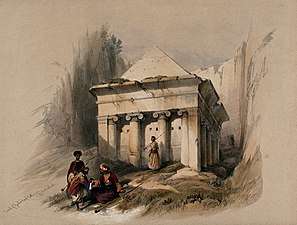


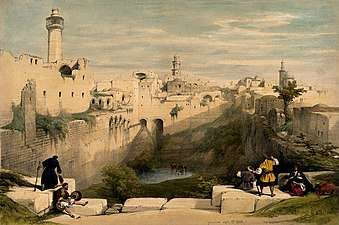
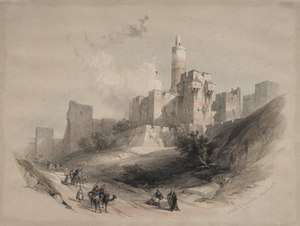
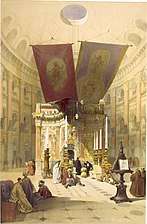
.tif.jpg)



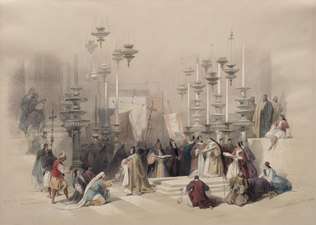
.tif.jpg)





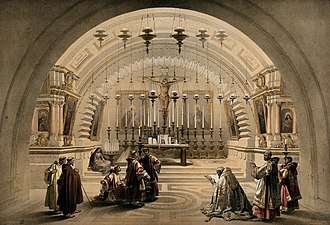
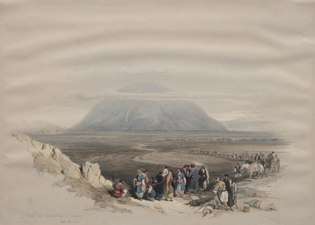
.tif.jpg)

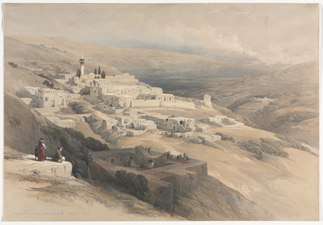
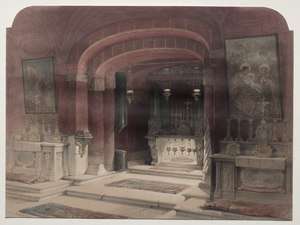
.tif.jpg)
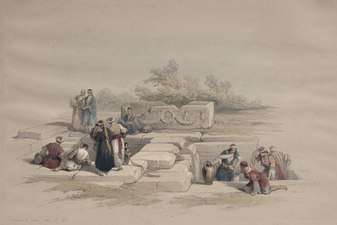
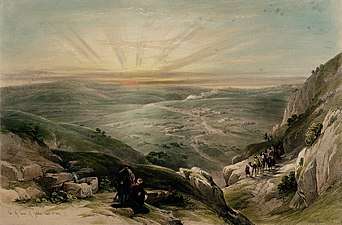
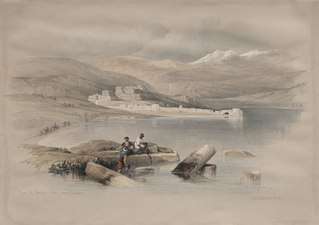
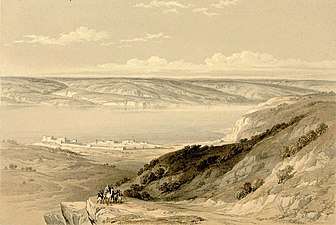
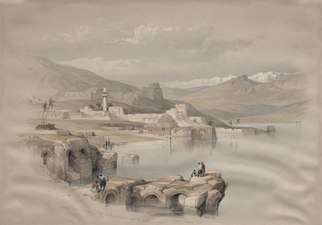

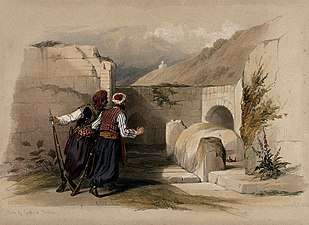
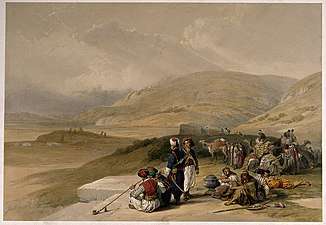




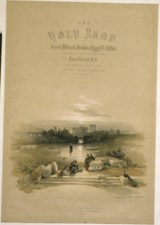

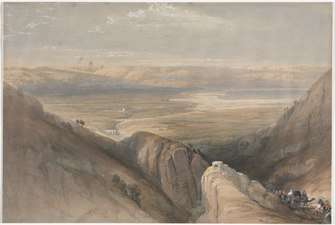
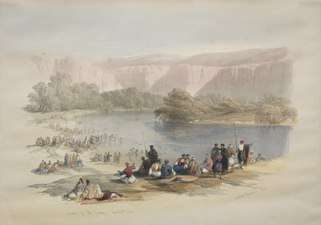
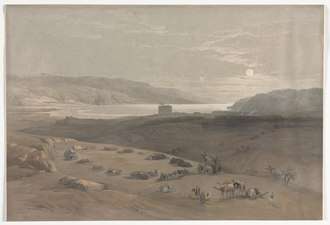

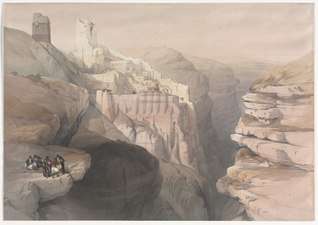
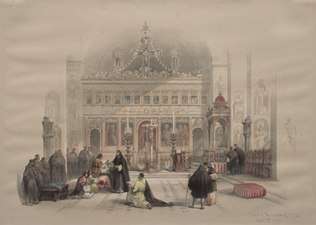
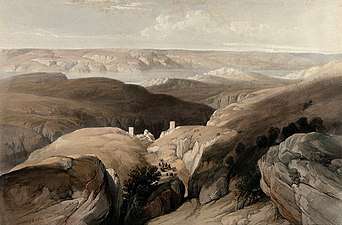


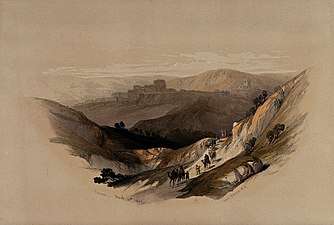



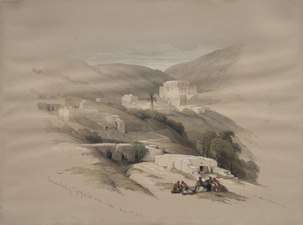
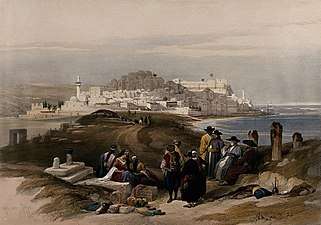
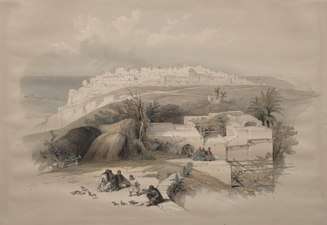

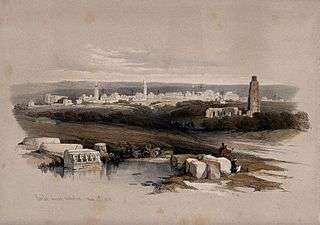



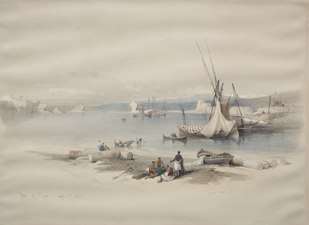
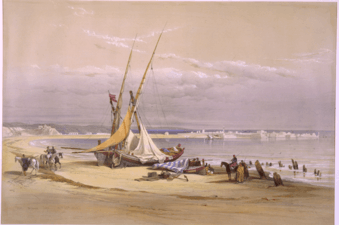


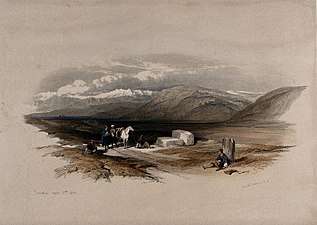
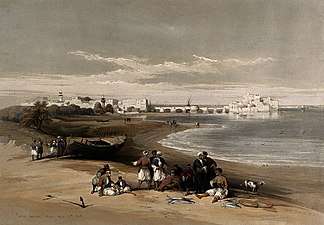







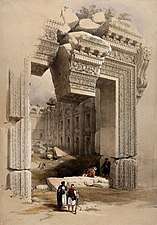
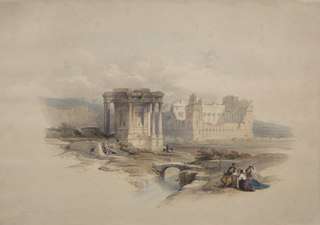

_by_David_Roberts%2C_RA.jpg)

